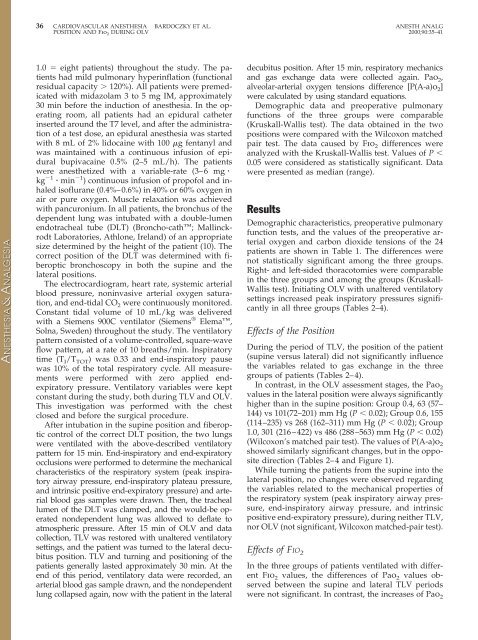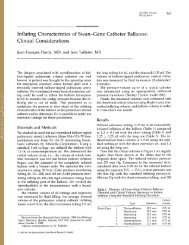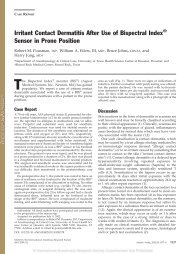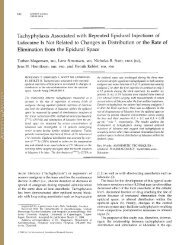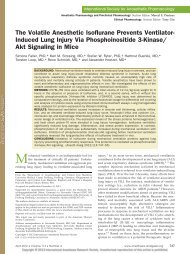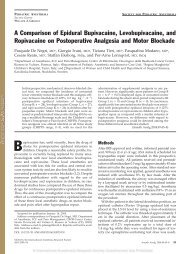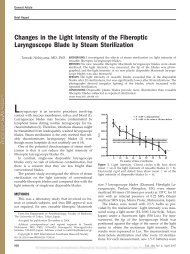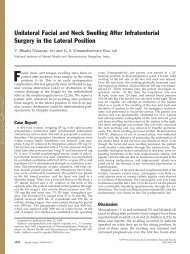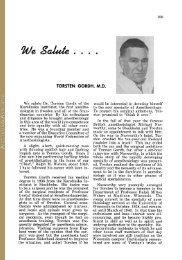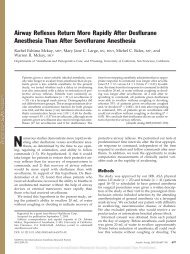Two-Lung and One-Lung Ventilation in Patients - Anesthesia ...
Two-Lung and One-Lung Ventilation in Patients - Anesthesia ...
Two-Lung and One-Lung Ventilation in Patients - Anesthesia ...
You also want an ePaper? Increase the reach of your titles
YUMPU automatically turns print PDFs into web optimized ePapers that Google loves.
36 CARDIOVASCULAR ANESTHESIA BARDOCZKY ET AL. ANESTH ANALG<br />
POSITION AND Fio 2 DURING OLV 2000;90:35–41<br />
1.0 eight patients) throughout the study. The patients<br />
had mild pulmonary hyper<strong>in</strong>flation (functional<br />
residual capacity 120%). All patients were premedicated<br />
with midazolam 3 to 5 mg IM, approximately<br />
30 m<strong>in</strong> before the <strong>in</strong>duction of anesthesia. In the operat<strong>in</strong>g<br />
room, all patients had an epidural catheter<br />
<strong>in</strong>serted around the T7 level, <strong>and</strong> after the adm<strong>in</strong>istration<br />
of a test dose, an epidural anesthesia was started<br />
with 8 mL of 2% lidoca<strong>in</strong>e with 100 g fentanyl <strong>and</strong><br />
was ma<strong>in</strong>ta<strong>in</strong>ed with a cont<strong>in</strong>uous <strong>in</strong>fusion of epidural<br />
bupivaca<strong>in</strong>e 0.5% (2–5 mL/h). The patients<br />
were anesthetized with a variable-rate (3–6 mg <br />
kg 1 m<strong>in</strong> 1 ) cont<strong>in</strong>uous <strong>in</strong>fusion of propofol <strong>and</strong> <strong>in</strong>haled<br />
isoflurane (0.4%–0.6%) <strong>in</strong> 40% or 60% oxygen <strong>in</strong><br />
air or pure oxygen. Muscle relaxation was achieved<br />
with pancuronium. In all patients, the bronchus of the<br />
dependent lung was <strong>in</strong>tubated with a double-lumen<br />
endotracheal tube (DLT) (Broncho-cath tm ; Mall<strong>in</strong>ckrodt<br />
Laboratories, Athlone, Irel<strong>and</strong>) of an appropriate<br />
size determ<strong>in</strong>ed by the height of the patient (10). The<br />
correct position of the DLT was determ<strong>in</strong>ed with fiberoptic<br />
bronchoscopy <strong>in</strong> both the sup<strong>in</strong>e <strong>and</strong> the<br />
lateral positions.<br />
The electrocardiogram, heart rate, systemic arterial<br />
blood pressure, non<strong>in</strong>vasive arterial oxygen saturation,<br />
<strong>and</strong> end-tidal CO 2 were cont<strong>in</strong>uously monitored.<br />
Constant tidal volume of 10 mL/kg was delivered<br />
with a Siemens 900C ventilator (Siemens ® Elema tm ,<br />
Solna, Sweden) throughout the study. The ventilatory<br />
pattern consisted of a volume-controlled, square-wave<br />
flow pattern, at a rate of 10 breaths/m<strong>in</strong>. Inspiratory<br />
time (T I/T TOT) was 0.33 <strong>and</strong> end-<strong>in</strong>spiratory pause<br />
was 10% of the total respiratory cycle. All measurements<br />
were performed with zero applied endexpiratory<br />
pressure. Ventilatory variables were kept<br />
constant dur<strong>in</strong>g the study, both dur<strong>in</strong>g TLV <strong>and</strong> OLV.<br />
This <strong>in</strong>vestigation was performed with the chest<br />
closed <strong>and</strong> before the surgical procedure.<br />
After <strong>in</strong>tubation <strong>in</strong> the sup<strong>in</strong>e position <strong>and</strong> fiberoptic<br />
control of the correct DLT position, the two lungs<br />
were ventilated with the above-described ventilatory<br />
pattern for 15 m<strong>in</strong>. End-<strong>in</strong>spiratory <strong>and</strong> end-expiratory<br />
occlusions were performed to determ<strong>in</strong>e the mechanical<br />
characteristics of the respiratory system (peak <strong>in</strong>spiratory<br />
airway pressure, end-<strong>in</strong>spiratory plateau pressure,<br />
<strong>and</strong> <strong>in</strong>tr<strong>in</strong>sic positive end-expiratory pressure) <strong>and</strong> arterial<br />
blood gas samples were drawn. Then, the tracheal<br />
lumen of the DLT was clamped, <strong>and</strong> the would-be operated<br />
nondependent lung was allowed to deflate to<br />
atmospheric pressure. After 15 m<strong>in</strong> of OLV <strong>and</strong> data<br />
collection, TLV was restored with unaltered ventilatory<br />
sett<strong>in</strong>gs, <strong>and</strong> the patient was turned to the lateral decubitus<br />
position. TLV <strong>and</strong> turn<strong>in</strong>g <strong>and</strong> position<strong>in</strong>g of the<br />
patients generally lasted approximately 30 m<strong>in</strong>. At the<br />
end of this period, ventilatory data were recorded, an<br />
arterial blood gas sample drawn, <strong>and</strong> the nondependent<br />
lung collapsed aga<strong>in</strong>, now with the patient <strong>in</strong> the lateral<br />
decubitus position. After 15 m<strong>in</strong>, respiratory mechanics<br />
<strong>and</strong> gas exchange data were collected aga<strong>in</strong>. Pao 2,<br />
alveolar-arterial oxygen tensions difference [P(A-a)o 2]<br />
were calculated by us<strong>in</strong>g st<strong>and</strong>ard equations.<br />
Demographic data <strong>and</strong> preoperative pulmonary<br />
functions of the three groups were comparable<br />
(Kruskall-Wallis test). The data obta<strong>in</strong>ed <strong>in</strong> the two<br />
positions were compared with the Wilcoxon matched<br />
pair test. The data caused by Fio 2 differences were<br />
analyzed with the Kruskall-Wallis test. Values of P <br />
0.05 were considered as statistically significant. Data<br />
were presented as median (range).<br />
Results<br />
Demographic characteristics, preoperative pulmonary<br />
function tests, <strong>and</strong> the values of the preoperative arterial<br />
oxygen <strong>and</strong> carbon dioxide tensions of the 24<br />
patients are shown <strong>in</strong> Table 1. The differences were<br />
not statistically significant among the three groups.<br />
Right- <strong>and</strong> left-sided thoracotomies were comparable<br />
<strong>in</strong> the three groups <strong>and</strong> among the groups (Kruskall-<br />
Wallis test). Initiat<strong>in</strong>g OLV with unaltered ventilatory<br />
sett<strong>in</strong>gs <strong>in</strong>creased peak <strong>in</strong>spiratory pressures significantly<br />
<strong>in</strong> all three groups (Tables 2–4).<br />
Effects of the Position<br />
Dur<strong>in</strong>g the period of TLV, the position of the patient<br />
(sup<strong>in</strong>e versus lateral) did not significantly <strong>in</strong>fluence<br />
the variables related to gas exchange <strong>in</strong> the three<br />
groups of patients (Tables 2–4).<br />
In contrast, <strong>in</strong> the OLV assessment stages, the Pao 2<br />
values <strong>in</strong> the lateral position were always significantly<br />
higher than <strong>in</strong> the sup<strong>in</strong>e position: Group 0.4, 63 (57–<br />
144) vs 101(72–201) mm Hg (P 0.02); Group 0.6, 155<br />
(114–235) vs 268 (162–311) mm Hg (P 0.02); Group<br />
1.0, 301 (216–422) vs 486 (288–563) mm Hg (P 0.02)<br />
(Wilcoxon’s matched pair test). The values of P(A-a)o 2<br />
showed similarly significant changes, but <strong>in</strong> the opposite<br />
direction (Tables 2–4 <strong>and</strong> Figure 1).<br />
While turn<strong>in</strong>g the patients from the sup<strong>in</strong>e <strong>in</strong>to the<br />
lateral position, no changes were observed regard<strong>in</strong>g<br />
the variables related to the mechanical properties of<br />
the respiratory system (peak <strong>in</strong>spiratory airway pressure,<br />
end-<strong>in</strong>spiratory airway pressure, <strong>and</strong> <strong>in</strong>tr<strong>in</strong>sic<br />
positive end-expiratory pressure), dur<strong>in</strong>g neither TLV,<br />
nor OLV (not significant, Wilcoxon matched-pair test).<br />
Effects of FIO 2<br />
In the three groups of patients ventilated with different<br />
Fio 2 values, the differences of Pao 2 values observed<br />
between the sup<strong>in</strong>e <strong>and</strong> lateral TLV periods<br />
were not significant. In contrast, the <strong>in</strong>creases of Pao 2


